This article is all about sharing some great examples of ABA (Applied Behavior Analysis) teaching strategies that can really boost children's learning! 🌟 Strategies like Discrete Trial Training, Natural Environment Teaching, and Functional Communication Training are designed to meet each child's unique needs. They're backed by data-driven insights, which helps create effective learning environments and promotes skill acquisition across different situations.
As parents, we know how important it is to find the right tools for our kids. These strategies not only support learning but also help children thrive in their everyday lives. Let’s explore this together and see how these approaches can make a difference! We’re here to help you every step of the way!
In the world of education, finding effective teaching strategies is so important, especially for children with unique learning needs. The use of Applied Behavior Analysis (ABA) opens up a treasure chest of techniques aimed at improving learning outcomes and promoting independence.
Let’s explore ten powerful ABA teaching strategies that not only cater to individual learning styles but also empower caregivers to take an active role in their child's educational journey.
How can these innovative approaches truly change the way children learn and engage with their surroundings? Dive into the world of ABA with us to discover methods that could redefine educational success for our young learners!
At Rori Care, we take a data-focused approach to craft personalized ABA therapy plans that cater to each child's unique needs. Our qualified behavior analysts design individualized plans filled with measurable goals and evidence-based strategies, which include ABA teaching strategies examples, to ensure that therapy is both accessible and effective. By conducting thorough assessments, our clinicians identify the best ABA teaching strategies examples, which create a nurturing learning environment where children can flourish and reach their goals.
The integration of advanced AI in ABA therapy has shown remarkable improvements in educational outcomes, extending treatment durations by 50%! For example, a recent study revealed that 76% of patients saw multiple goals trending upwards after adopting a hybrid ABA treatment model. This truly highlights the power of ABA teaching strategies examples in education. Our clinicians stress that ongoing data collection is vital for evaluating intervention success and making informed adjustments, ultimately fostering a collaborative atmosphere between therapists and families. As Dassy Coleman, a Licensed Behavioral Specialist, wisely noted, 'Data-driven decision-making is essential in ABA therapy, enabling us to customize interventions that genuinely connect with each individual's learning journey.' This commitment to personalized care not only supports development but also empowers families to actively participate in their child's progress.
To get started, we invite you to a complimentary consultation to discuss your son’s or daughter’s needs. Let’s explore this together!
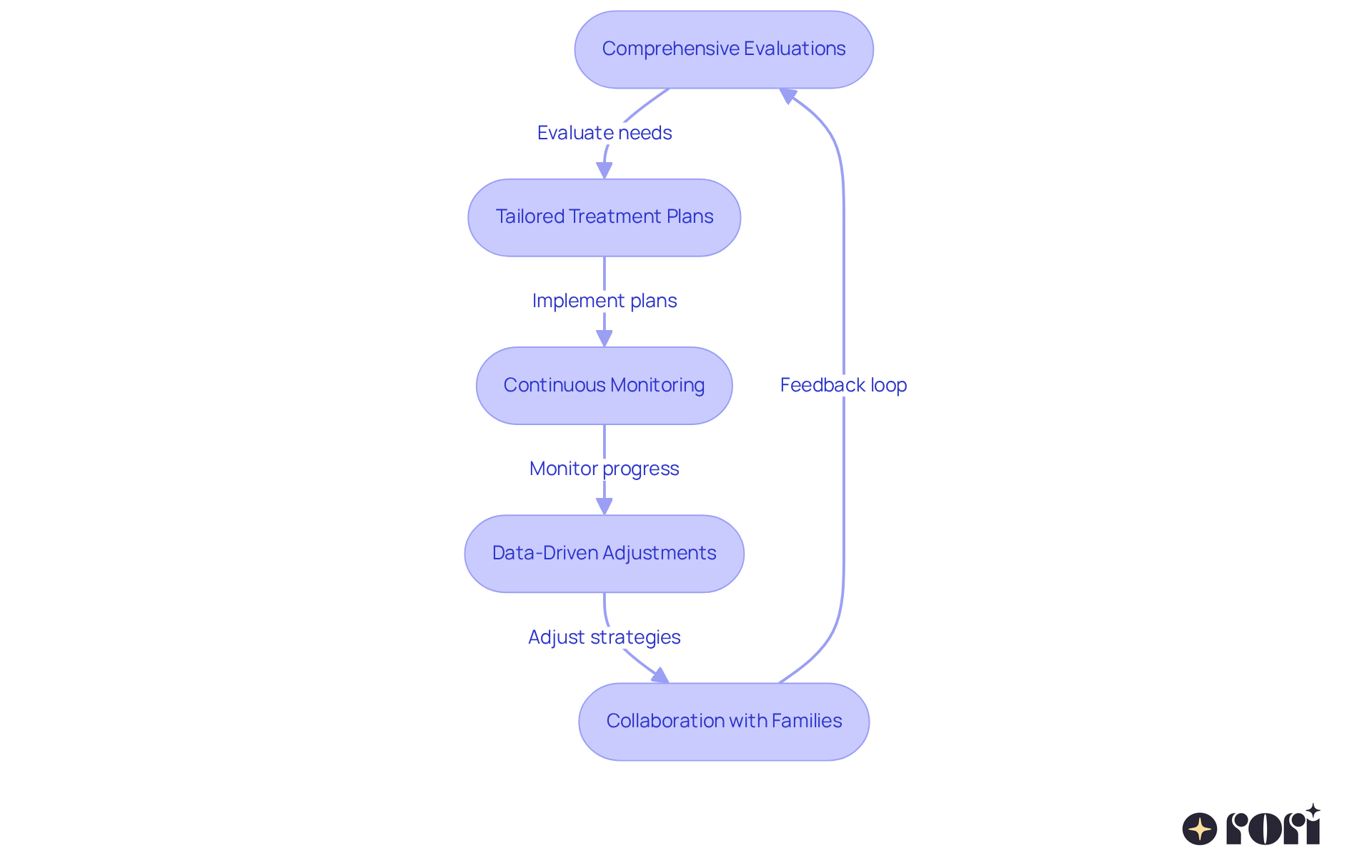
Discrete Trial Training (DTT) is a systematic method that provides ABA teaching strategies examples by breaking down skills into small, manageable parts, making it easier for focused instruction and reinforcement. Each trial includes a clear instruction, the participant's response, and a consequence, which may be positive reinforcement or corrective feedback. This organized approach not only helps in gaining new skills but also allows for precise tracking of progress and mastery, which aligns perfectly with the personalized planning and measurable objectives found in effective ABA teaching strategies examples.
The transformative impact of DTT in autism education is demonstrated through ABA teaching strategies examples. For example, a study comparing traditional DTT with embedded DTT found both methods equally effective in teaching receptive discriminations. However, embedded DTT led to higher levels of positive feelings among participants. This suggests that incorporating play-based elements can enhance engagement and educational outcomes.
Moreover, ABA therapists emphasize the importance of organized education in fostering independence and social skills. They observe that DTT not only teaches specific skills but also boosts overall confidence and initiative in social interactions. This ultimately supports better family dynamics and community involvement. By utilizing DTT and applying ABA teaching strategies examples, families can empower their children to thrive in various environments, reinforcing the idea that structured education is a cornerstone of effective ABA therapy. Additionally, caregiver training is vital in this journey, equipping parents with the knowledge and skills needed to support their children's behavioral goals through active participation and data collection.
Let’s explore this together! We’re here to help you every step of the way!
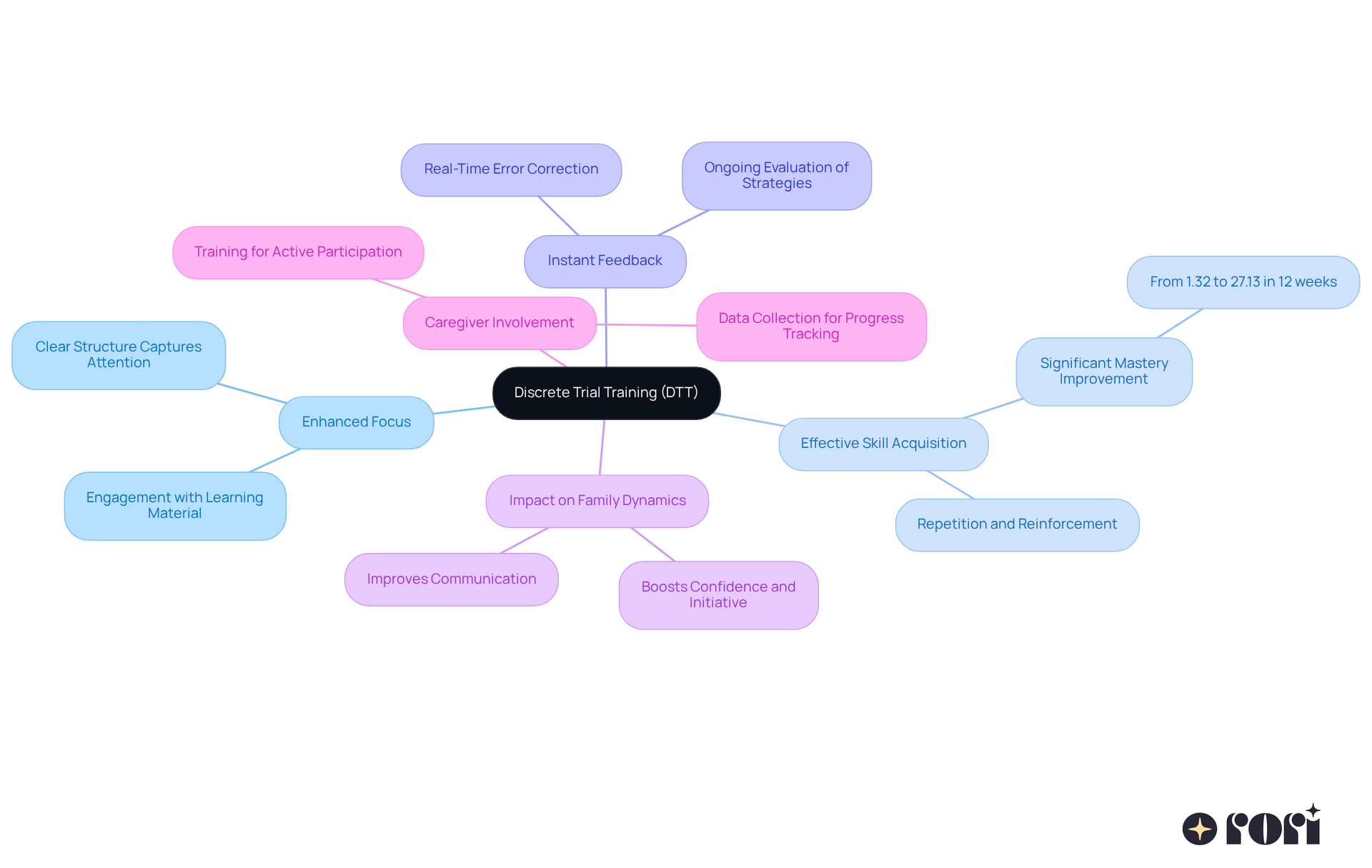
Natural Environment Teaching (NET) highlights how important it is to weave education into everyday activities like playtime and family routines. When children learn through real-life situations, they’re more likely to engage and retain new skills. This approach makes learning enjoyable and encourages spontaneous communication and socialization, which are vital for their development. Caregivers who understand ABA teaching strategies examples can significantly enhance this process by providing effective behavioral support in these natural settings.
Functional Skill Development: NET uses everyday interactions to teach practical skills, making learning relevant and immediately applicable. For instance, during snack time, kids can learn to request items, which reinforces their communication skills in a natural context. Caregivers who grasp ABA can align their support with these moments, maximizing the impact of the intervention.
Child-Led Learning: Encouraging child-initiated activities boosts motivation and engagement. Kids are more inclined to participate when they can explore their interests, making education feel like play rather than a chore. As Yitz Diena notes, 'Natural Environment Teaching (NET) is one of the ABA teaching strategies examples that focuses on learning through natural interactions and situations pertinent to the individual's life.' Caregivers’ active involvement in these activities allows them to make informed choices that positively affect their children’s progress.
Skill Generalization: Skills learned through NET tend to transfer across different environments, like home, school, and community settings. Research shows that children engaged in NET demonstrate improved adaptive skills and social interactions, practicing in diverse real-world contexts. Educating caregivers enhances their ability to support this generalization effectively through ABA teaching strategies examples, strategy alignment, and data collection.
The benefits of learning through everyday interactions are truly profound. Research indicates that children receiving early intervention, particularly through NET, develop functional communication skills at a rate of up to 90%. Plus, incorporating educational experiences in familiar settings not only boosts skill acquisition but also fosters a sense of ownership and confidence in learners. This comprehensive approach ensures that young individuals are better prepared for real-world challenges, leading to improved educational outcomes and quality of life for families.
To incorporate NET strategies into your daily routines, think about using snack time or playtime as opportunities to teach functional skills. For example, encourage your child to request a specific snack by name, which enhances their communication abilities while making the learning experience enjoyable. Additionally, keep track of your child’s progress by noting their achievements and areas for improvement, helping you align your strategies effectively. Let’s explore this together!
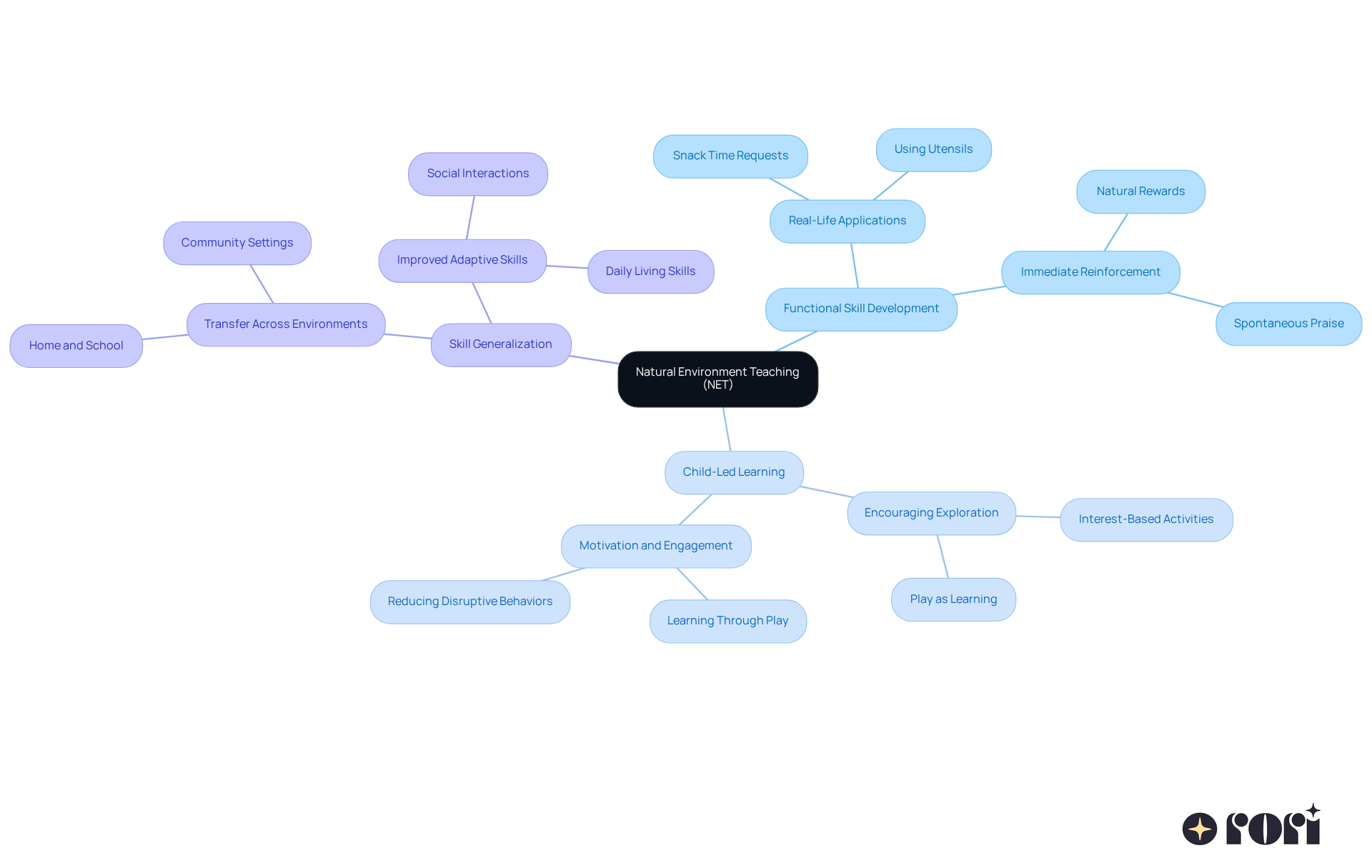
Pivotal Response Treatment (PRT) is a dynamic, play-based intervention that focuses on enhancing key developmental areas like motivation, self-management, and social initiations. By tapping into a young person's interests, PRT not only promotes active involvement but also significantly boosts engagement levels. This method has shown great promise in enhancing social abilities while encouraging independence and self-control, making it particularly beneficial for individuals with Autism Spectrum Disorders, ADHD, and other disabilities across all ages.
Benefits of PRT:
Real-life examples demonstrate the effectiveness of ABA teaching strategies examples in action. For instance, youth participating in PRT interventions have demonstrated notable improvements in task completion rates and fewer behavioral interruptions, which serve as ABA teaching strategies examples. This highlights the positive impact of focused motivational approaches. Therapists have noticed that incorporating play-based methods not only increases involvement but also creates a more supportive educational environment, leading to better outcomes for individuals with Autism Spectrum Disorder (ASD). Plus, positive reinforcement techniques, such as verbal praise and tangible rewards, further enhance these benefits, reinforcing desired behaviors and encouraging ongoing participation in learning activities.
Moreover, the success of PRT is significantly amplified by active caregiver involvement. Caregivers equipped with ABA principles and techniques can effectively support their children’s behavioral goals, ensuring consistency between home and therapy settings. As Dr. Jack Michael points out, understanding the impact of motivational factors is crucial for successful education in youth with ASD. By incorporating play-based strategies at home, parents can create an engaging environment that aligns with their children's interests, boosting motivation and learning outcomes. Plus, our behavior care engine revises intervention plans based on progress reports, ensuring that treatment remains flexible and responsive to each individual’s needs.
Let’s explore this together! We’re here to help you every step of the way!
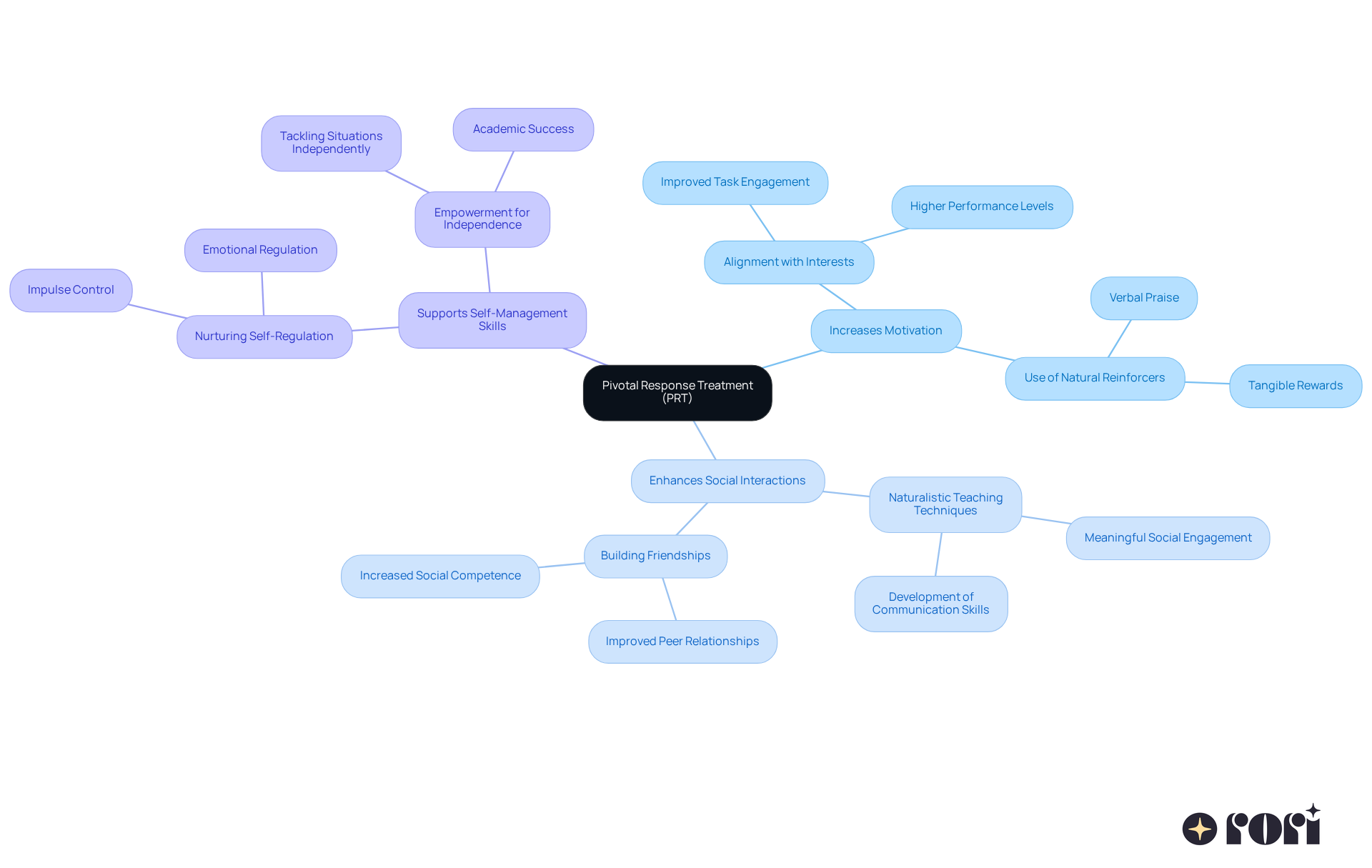
A token economy is a structured reinforcement system that serves as one of the aba teaching strategies examples, where kids earn tokens for showing desired behaviors. These tokens can be exchanged for rewards, creating a tangible incentive that not only reinforces positive behavior but also serves as aba teaching strategies examples in teaching valuable lessons about delayed gratification and self-control. This approach works especially well for kids with neurodiversities, like autism and ADHD, and is among the aba teaching strategies examples that boost motivation and engagement in learning environments.
Research shows that aba teaching strategies examples like token economies can significantly improve behavioral outcomes. Studies indicate increases in appropriate behaviors and decreases in inappropriate ones among individuals with developmental disabilities. For instance, a study published in the Journal of Applied Behavior Analysis provided aba teaching strategies examples, highlighting how token economies effectively improved social skills and communication in youth with autism spectrum disorder (ASD).
Behavior analysts emphasize the importance of prompt reinforcement in these systems. It helps young individuals clearly connect their actions with rewards, which is essential for effective understanding and behavior modification. Plus, the flexibility of token economies provides aba teaching strategies examples that allow them to adapt to various neurodiverse learners, ensuring that interventions stay effective and engaging.
However, it’s important to be aware of potential challenges, like token satiation, where kids might lose interest in tokens over time. This can make them less effective as motivators. To keep things fresh, parents and educators should regularly assess and adjust the token system to maintain engagement.
In real-world applications, educators often implement aba teaching strategies examples like token boards in classrooms to boost student engagement and promote positive behaviors. These systems not only encourage kids to complete tasks but also foster a supportive learning atmosphere. By linking tokens to inherent rewards, children can gradually shift from relying solely on external motivations to finding fulfillment in their achievements.
Consider creating a token chart at home that outlines specific behaviors you want to encourage in your child. This visual aid can help track progress and make the reinforcement process more engaging. Plus, Rori Care offers complimentary consultations with Board Certified Behavior Analysts to help families tackle behavioral challenges and create customized support strategies. We’re here to help you every step of the way!
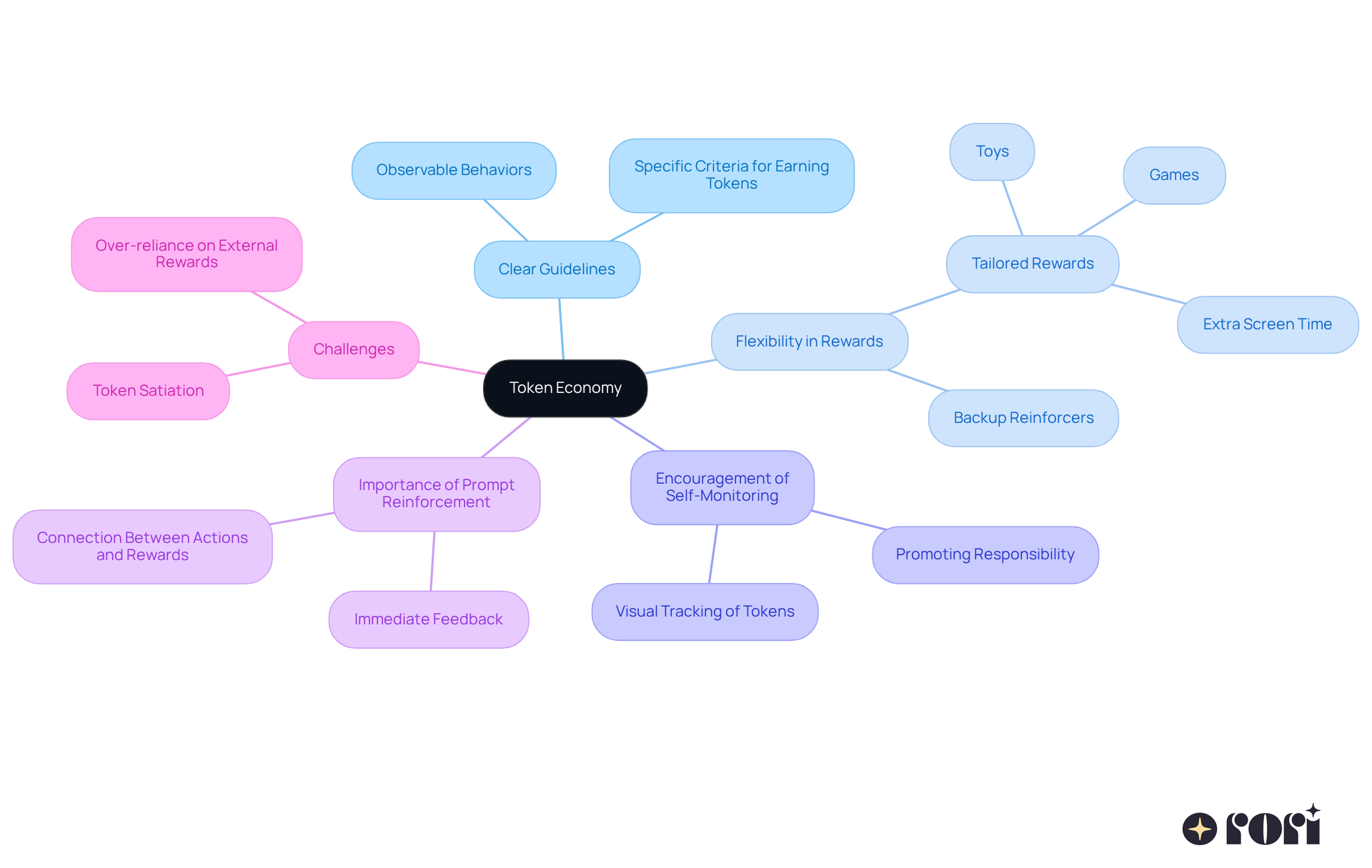
Functional Communication Training (FCT) is all about swapping out those challenging behaviors for some effective communication methods. By teaching young individuals how to express their needs and desires clearly, FCT helps to reduce frustration and boost social interactions. This approach is especially beneficial for children who may struggle with verbal communication. Plus, it often gets a nice boost from social interaction group therapy led by qualified therapists, which helps kids build better skills and connections with their peers.
Benefits of FCT:
Let’s explore this together! FCT is a wonderful way to help our kids thrive, and we’re here to help you every step of the way!

Shaping is such a fundamental technique in Applied Behavior Analysis (ABA)! It involves reinforcing those little steps toward a desired behavior. By breaking down complex skills into smaller, manageable pieces, kids can gradually learn and master new behaviors. This approach works wonders for tasks that might seem overwhelming at first, like brushing their teeth or tying their shoes.
Focus on Gradual Progress: Each step is celebrated, allowing children to build confidence as they achieve those small victories. This aligns perfectly with the measurable goals set in their individualized behavioral plans, giving clear benchmarks for progress.
Encouragement of Persistence: This method nurtures resilience, helping youngsters understand that learning is a journey that takes patience and effort. Plus, by continuously assessing and adjusting care plans, we ensure that our approaches remain effective and responsive to each child's unique needs.
Shaping is all about creating personalized learning experiences, as demonstrated by ABA teaching strategies examples, catering to each student’s individual needs and learning style. This is a key part of our program development service, and it’s so important!
Grounded in evidence-based strategies, shaping is among the effective ABA teaching strategies examples used in ABA therapy. For instance, when teaching a child to wear a coat, we might start by reinforcing them just for touching the coat, then for putting one arm in a sleeve, and gradually working up to wearing the coat completely. This gradual reinforcement not only eases anxiety but also boosts their motivation to engage in the task.
Clinicians often highlight how gradual reinforcement fosters a supportive educational environment. As one expert beautifully put it, 'By focusing on progressive approximations, we can help learners feel capable and celebrated for their efforts, even if they don’t immediately meet the end goal.' Celebrating every little accomplishment can truly enhance a child's confidence and eagerness to learn.
Additionally, when we equip caregivers with ABA principles and techniques, it really improves their ability to support their child's learning at home. Active involvement from caregivers, informed by ongoing data collection and education, leads to better behavioral outcomes and a more consistent approach to therapy. Educating caregivers is vital—it gives them the tools to reinforce shaping techniques effectively, further boosting their child’s progress. Overall, shaping is a powerful strategy among the ABA teaching strategies examples in ABA therapy that transforms challenges into manageable tasks, paving the way for lasting growth and success in individuals with autism. Let’s explore this together!
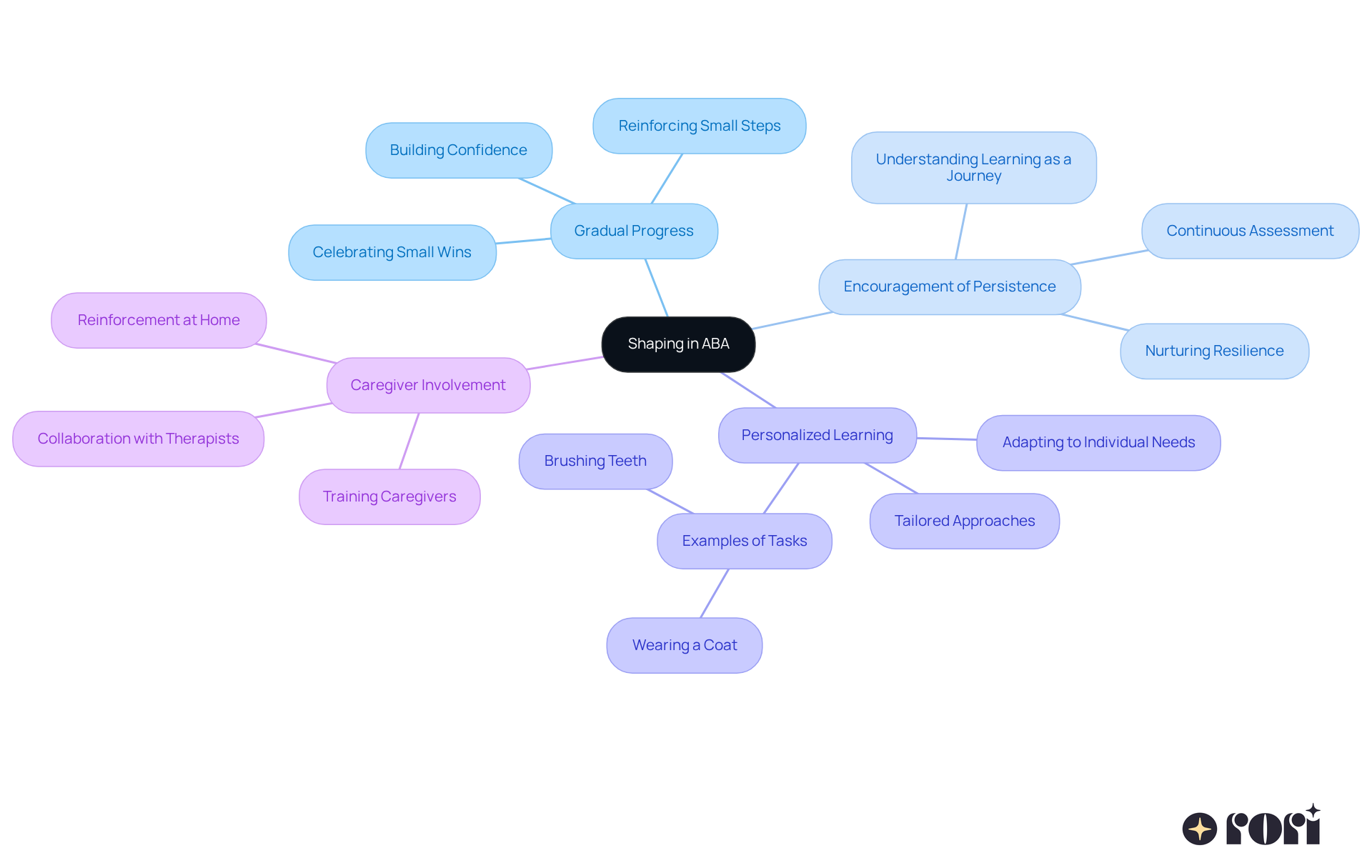
Prompting is a fundamental technique in Applied Behavior Analysis (ABA) that helps individuals engage in desired behaviors. It's all about providing cues or assistance to guide learners toward independence and skill mastery, especially when caregivers are actively involved. There are various types of prompts tailored to the individual needs of the child, including:
The ultimate goal of prompting is to gradually fade these supports as the individual becomes more proficient and independent in performing the behavior. Research shows that effective prompting strategies can significantly enhance skill acquisition and behavioral outcomes. In fact, when caregivers are actively engaged in applying ABA therapy, 90% of youth make substantial advancements.
Current research emphasizes the importance of tailoring prompting techniques to individual learners. A systematic method for fading prompts is crucial, as incorrect fading can lead to prompt dependency, where the individual relies too much on cues and struggles to complete tasks independently. By effectively executing prompt hierarchies—which may involve a mix of verbal, gestural, and visual prompts—we can promote independence and boost confidence in individuals with autism. This systematic evaluation process ensures that interventions remain effective and responsive to the individual's evolving needs.
Real-life examples serve to highlight the effectiveness of ABA teaching strategies. For instance, a young learner learning to greet others may start with a physical prompt, like a gentle nudge, followed by a verbal prompt, and eventually transition to independent greetings as they gain confidence. This gradual reduction of support not only enhances the individual's ability to navigate social interactions but also reinforces their self-esteem. With proper implementation of systematic fading, success rates of 80-90% are typically achieved.
In summary, prompting is essential to ABA therapy, guiding youngsters toward desired behaviors and facilitating significant behavioral changes. By utilizing ABA teaching strategies that involve a range of prompting methods and gradually reducing them, caregivers and therapists can help young individuals attain greater independence and success in their daily lives. As experts say, "Prompting is integral to Applied Behavior Analysis (ABA) therapy, serving as a structured method to guide learners toward appropriate responses." Let’s explore this together!
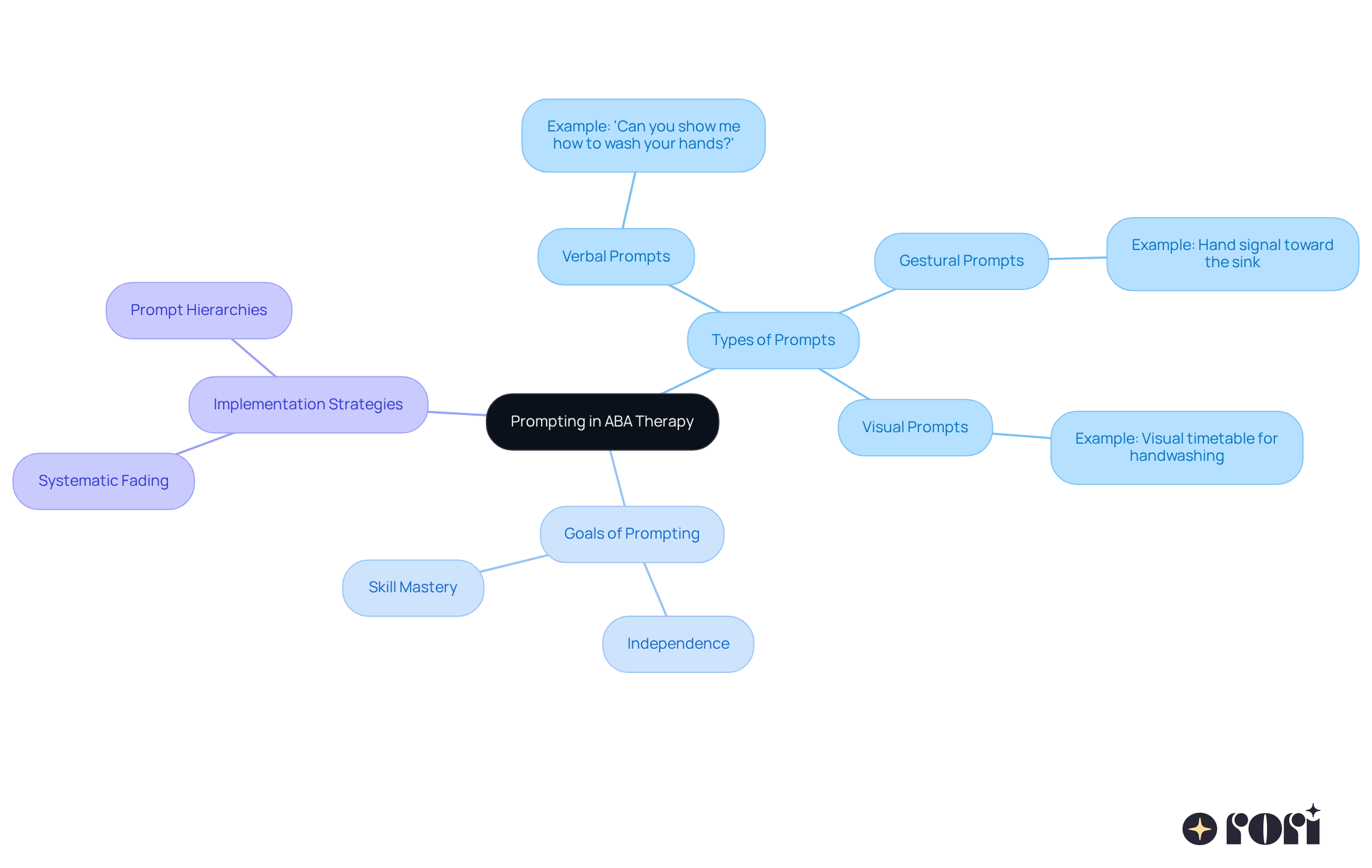
Behavioral rehearsal is such a powerful method! It involves practicing specific skills or behaviors in controlled environments, often through role-playing or simulations. This approach allows young individuals to build their skills and gain confidence before they use them in real-life situations. By creating opportunities for practice, behavioral rehearsal significantly boosts learning and retention, especially in social skills group therapy offered by Rori Care.
Benefits of Behavioral Rehearsal:
Integrating role-playing into educational approaches, which are among the aba teaching strategies examples, not only boosts youths' confidence but also equips them with crucial social skills. This makes aba teaching strategies examples a vital element of effective education, particularly for individuals on the autism spectrum. Plus, debriefing sessions after role-play activities are so important for reinforcing learning outcomes and improving self-awareness. They allow young individuals to reflect on their experiences and apply what they’ve learned. Caregiver education is also a key part of this process, enabling parents to support their children’s behavioral goals through active participation and data collection.
Additionally, Rori Care's clinical leadership team is dedicated to ensuring these therapeutic approaches are effectively executed, reinforcing their commitment to neurodiversity and children's success. However, it’s important for educators to be aware of potential classroom management challenges that may pop up during role-playing. Implementing strategies to address these issues is crucial for ensuring a productive learning environment. Let’s explore this together!
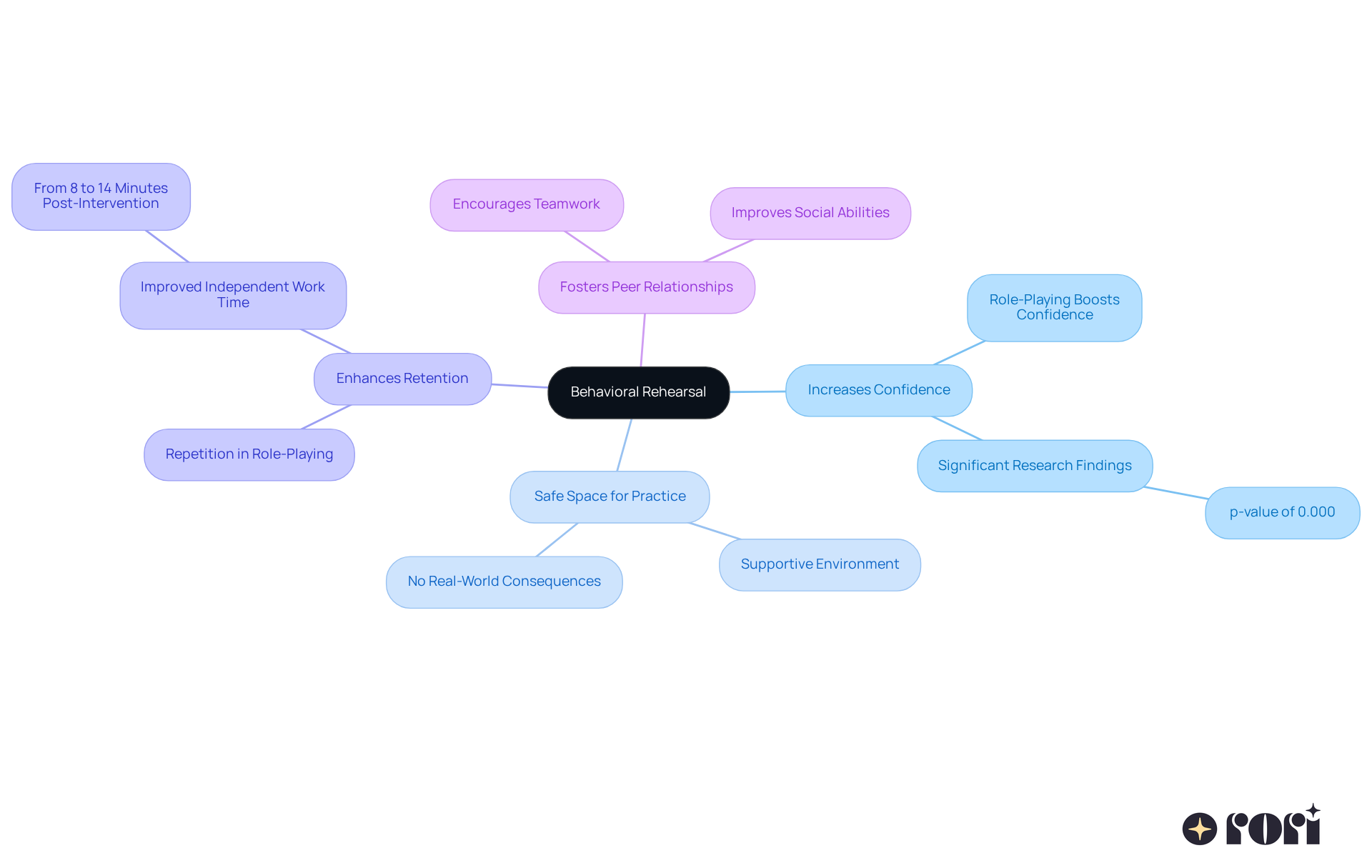
Generalization training is so important! It helps ensure that the skills learned in one place can be used in many different settings, like at home, school, or in the community. This method really promotes independence and boosts practical abilities for individuals with autism. Studies show that when young people practice skills in various environments, they’re much more likely to remember and apply these skills in real-life situations, which can significantly improve their overall quality of life.
Key Strategies for Generalization:
Behavior analysts emphasize that the use of learned skills, as demonstrated in aba teaching strategies examples, is key to fostering independence in individuals with autism. As one specialist noted, "The ability to generalize skills promotes independence among individuals with autism, allowing them to manage daily tasks and enhance social interactions, ultimately improving their well-being."
Integrating these strategies into daily routines not only helps with skill application but also allows caregivers to actively participate in their child’s development. By understanding and applying these approaches, caregivers can set measurable goals that improve behavioral outcomes, leading to greater self-sufficiency and better social relationships. Let’s explore this together!

This article shines a light on the transformative potential of various ABA teaching strategies that can truly enhance children's learning experiences. By using personalized approaches—like Discrete Trial Training, Natural Environment Teaching, and Pivotal Response Treatment—caregivers and educators can create effective learning environments tailored to each child's unique needs. These strategies not only help children acquire essential skills but also encourage independence and social interaction, ultimately boosting their confidence.
Key insights from the article reveal how structured interventions, such as token economies and functional communication training, reinforce positive behaviors and improve communication skills. Techniques like prompting and shaping play a vital role in supporting children's development by guiding them toward desired behaviors and celebrating their incremental progress. These evidence-based methods highlight the importance of continuous assessment and adaptation, ensuring that interventions remain relevant and effective.
Incorporating these ABA teaching strategies into daily routines can significantly impact children's learning and development. Engaging caregivers in this journey empowers them to actively support their child's progress, creating a collaborative atmosphere that enhances outcomes. By embracing these approaches, families can nurture not only academic success but also improved social skills and overall quality of life. Remember, the journey of learning is a partnership, and with the right strategies in place, every child can truly thrive. Let’s explore this together!
What is Rori Care's approach to ABA therapy?
Rori Care utilizes a data-focused approach to create personalized ABA therapy plans tailored to each child's unique needs, incorporating measurable goals and evidence-based strategies.
How does Rori Care ensure the effectiveness of its therapy plans?
Qualified behavior analysts conduct thorough assessments to identify the best ABA teaching strategies, allowing for targeted interventions that are continuously monitored and adjusted based on the child's progress.
What role does AI play in Rori Care's ABA therapy?
The integration of advanced AI in ABA therapy has improved educational outcomes, with studies showing a 50% increase in treatment durations and 76% of patients achieving multiple goals after adopting a hybrid ABA treatment model.
What is Discrete Trial Training (DTT)?
DTT is a systematic method that breaks down skills into smaller parts for focused instruction and reinforcement, including clear instructions, participant responses, and consequences.
What are the benefits of Discrete Trial Training (DTT)?
DTT enhances focus, promotes effective skill acquisition through repetition and reinforcement, and provides instant feedback, which boosts educational efficiency.
How does DTT compare to other methods in teaching skills?
Studies show that both traditional DTT and embedded DTT are effective in teaching skills, but embedded DTT may lead to higher levels of positive feelings among participants due to its play-based elements.
What is Natural Environment Teaching (NET)?
NET emphasizes learning through everyday interactions, making education relevant and enjoyable by integrating it into activities like playtime and family routines.
How does NET support functional skill development?
NET uses real-life situations to teach practical skills, such as communication during snack time, which caregivers can enhance by providing effective behavioral support.
What is the impact of child-led learning in NET?
Child-initiated activities increase motivation and engagement, allowing children to explore their interests, making learning feel like play rather than a chore.
What are the benefits of learning through everyday interactions in NET?
Children engaged in NET show improved adaptive skills and social interactions, with research indicating that early intervention through NET can lead to a 90% rate of functional communication skills development.